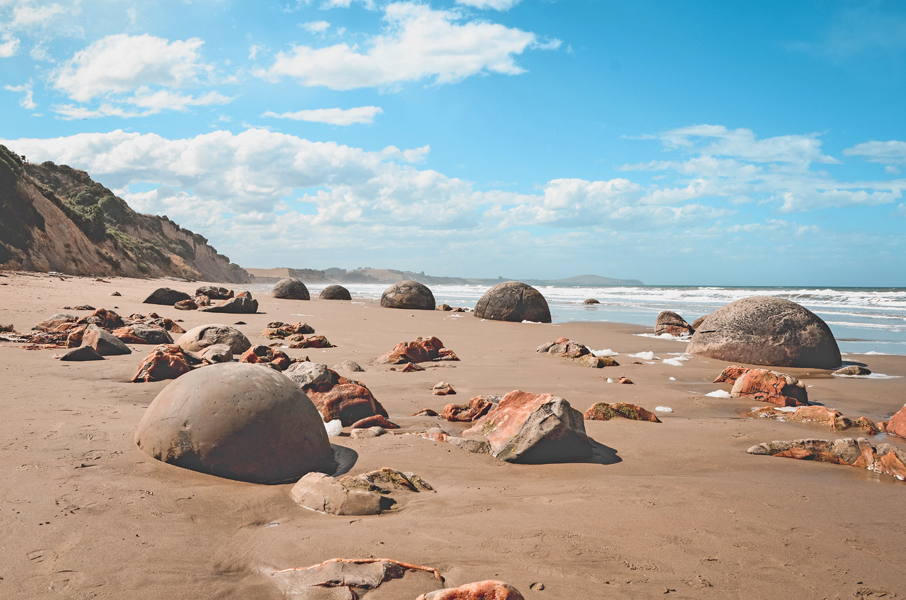Moeraki Boulders are a group of large spherical boulders on Koekohe Beach in the Otago region on the southeast coast of New Zealand’s South Island.
In 1848, W. B. D. Mantell made sketches of the beach and its rocks, much more numerous than now. The image is now in the Alexander Turnbull Library in Wellington. The stones have been described in colonial reports from 1850 and in numerous popular articles since that time.
Several hundred stone balls lie in a strip of coastal sand for about 300 meters. The diameter of the boulders ranges from 0.5 to 2.2 m. In terms of geology, they are nodules recovered by water erosion from the Paleocene mudstone.
The surface of some balls may be absolutely smooth, while others are rough with patterns reminiscent of those found on the shell of turtles. Some boulders lie on the beach, others are located in the sea, some of them have split over the years and only pieces remain of them.
Bizarre hills rise behind the stones. Local aborigines told white people the story of the appearance of large stones and hills on the coast.According to the legends of the Maori tribe, boulders are nothing more than food, namely, pumpkins, potatoes, etc.
Moeraki Boulders have become a popular tourist attraction,The attraction is well advertised often described and depicted on web pages and in tourist guides. websites created to attract travelers to the boulders,tourists from different parts of the world come to the Koehohe beach to admire this strange phenomenon but also to enjoy the wonderful beach.
Access : Coordinates: -45.345275, 170.826061 / The road to Koehohe Beach follows the picturesque Otago Bay. The length of the beach, dotted with ancient stones, is approximately 300 meters.
Highlights :
- Legend : According to the legends of the Maori tribe, boulders are nothing more than food, namely, pumpkins, potatoes, etc., which came here from the wrecked mythical konoe Arai-te-uru.
- The boulders were examined by scientists using X-rays and electron probe microscopes, and it was found that the boulders are composed of sand, silt and clay, cemented by calcite.
- How could such unusual boulders have formed?scientists have their own assumption on this – they arose 65.5 – 56 million years ago (in the Paleocene of the Cenozoic era) and the composition of the mud from the center of the ball showed that they began to form on the surface of the seabed. The stones were born, like pearls in the shell of a mollusk, in liquid mud. This factor led to their streamlined shape. The core, floating in the liquid, built up layers, absorbing all available components, and then solidified. Stone formations of this type are called septarium nodules.
- Aliens : According to this version, the stones are the work of aliens who have created disguised transmitters for their needs or simply left offspring.
Activities : sightseeing / photo opportunities,the area boasts a beautiful beach and charming sunsets. / sunbathing and swimming.
Go next : Hampden, a small town in North Otago / Dunedin ,the second-largest city in the South Island of New Zealand / Moeraki is a small fishing town on the east coast of the South Island of New Zealand.

